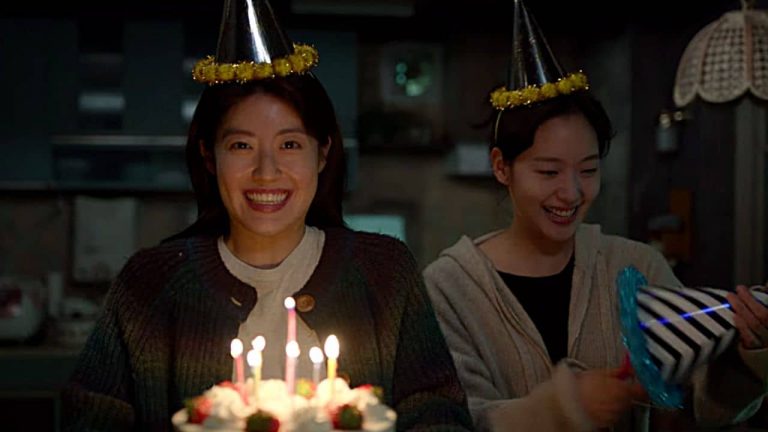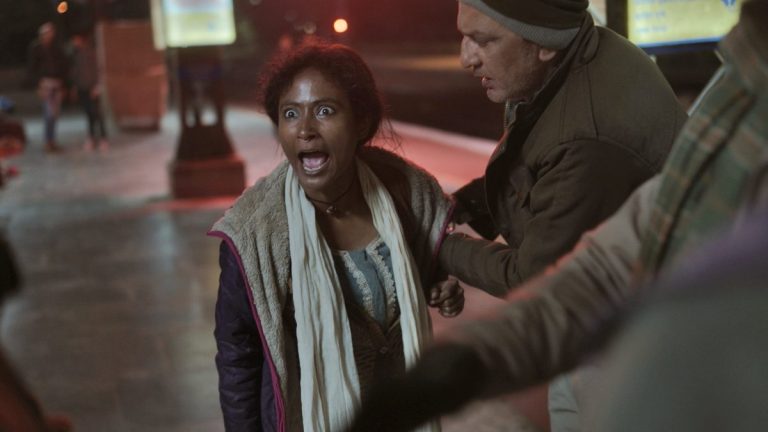I could never forget East Bengal. I am still under the spell of the open fields, the paddy fields, the blue sky, and above all, the river Padma.
– Ritwik Ghatak
Keywords: Padma, River, Bengal, Border, Partition
Rivers function both as actual life sources and a symbolic force, connecting the lives of divided peoples from West Bengal and Bangladesh. Scholar Madhuja Mukherjee writes that the films of Ritwik Ghatak focus on the riverine landscape of Bangladesh, with the River Padma at the center stage. The River Padma was lost during the Partition of India in 1947. Ghatak’s “Komal Gandhar” (A Soft Note on a Sharp Scale, 1961) narrates the anguish and political and cultural crises following partition and forced migration, after the loss of the River Padma.
This article reads through existing scholarship to make sense of the riverscape of Padma in Ritwik Ghatak’s often underappreciated film, Komal Gandhar.
River Padma
In East Bengal, present-day Bangladesh, one major distributary of the Ganges is known as the Padma River. River Padma was held as a marker to distinguish and define epar Bangla (East Bengal) and opar Bangla (West Bengal). The Partition of India created a new international border, replacing the river as the new marker to demarcate the two sides of Bengal.

The Refugee Director
Born in Dacca in undivided Bengal in 1925, Ritwik Ghatak was at the forefront in producing narratives about the journey from desh to Calcutta, especially the post-Partition permanent immigration to a point of no return. His family moved first to Berhampore, Murshidabad, and eventually to Calcutta (now Kolkata). The Partition of India and its bloody aftermath had lasting effect on Ritwik and he believed that the ‘whole and glorious’ Bengal that he was born into was ‘shattered by the war, the famine, and (…) the Congress and the Muslim League’ who ‘tore it into two to snatch for it a fragmented independence’.
He was associated with the thespian wing of the Communist Party of India, the Indian People’s Theatre Association. The disintegration of the IPTA (Indian People’s Theatre Association) impacted Ghatak, and he conjoined the motif of fragmentation of a revolutionary cultural movement with a broader motif, the fragmentation of a people. Thus, “Komal Gandhar” was born.
A Soft Note On A Sharp Scale On The Banks Of The Padma
The second film of the Partition trilogy merges the split of a movement with the permanent fracture of a land to tell a story of lament, languish, and longing. “Komal Gandhar,” released in 1961, features two theatre-performers from two rival theatre groups (Dakshinapath and Niriksha), Bhrigu and Anasyua, an allusion to a factional struggle within the Indian Peoples’ Theatre Association (IPTA).
After Bhrigu receives an offer to stage a play, the united theatre group arrives at Lalgola, an Indian border town on the banks of the Padma. In this particular moment of a film, the film develops a twin focus. On one hand, the members of the group enjoy their break from rehearsals by watching boats race along the glistening river. The boatmen sing songs, offering to the river goddess. The conflict between the two rival groups cools off as they sing “bhatiali gan” with the boatmen. Ghatak weaves together portions and lines of bhatiali gan in homage to the Padma River.
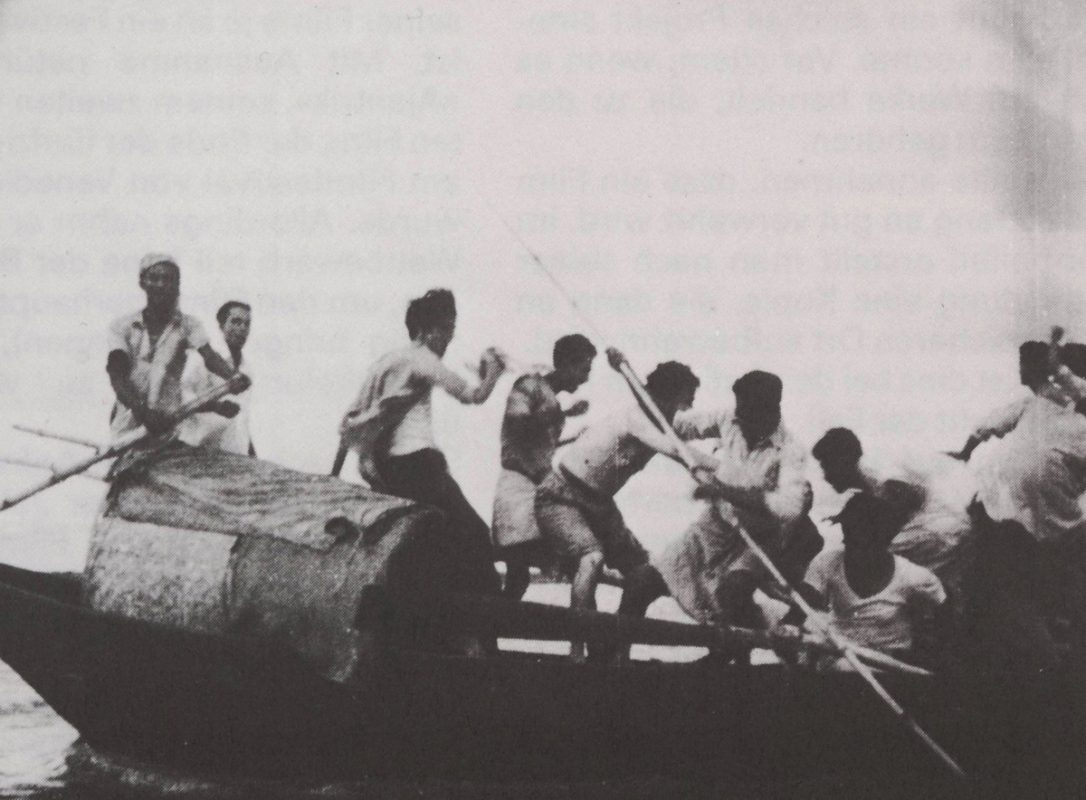
On another hand, the two members of the group, Bhrigu and Anasuya, isolate themselves from the group and gaze wistfully across the river on the other side, which was once their ancestral land. They wander and reminisce about their childhood in East Bengal, which lies just across the river Padma. The two orphans converse about their profound grief: Bhrigu declares his attachment to East Bengal, saying, “Why should I leave? Leave my fertile land, the Padma River, why should I go?” Anasuya recalls, “My mother died during the Noakhali riots. She was like a flame.” Afterwards, Anasuya discloses that Bhrigu’s spirit reminds her of her mother’s. “She had your eyes, Bhrigu,” recalls Anasuya to Bhrigu, suggesting that he is almost her mother’s son, almost her twin.
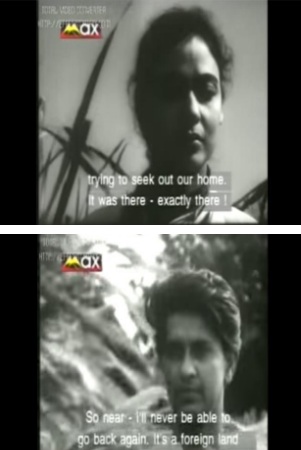
Related Read: The Conflict of Reason and Ruin: A Marxist-Psychoanalytic Reading of Ghatak’s ‘Jukti Takko Aar Gappo’ Through an Absurdist Lens
A metaphor of joining and disjoining runs throughout the film, evoking the image of Ghatak’s beloved Bengal – disjoined and out of joint. This image is seen when the silver, glimmering Padma River flows like a mirror that simultaneously cuts and reflects the two Bengals.
The conversation between the two characters fills the frame with a sense of longing and nostalgia, undercutting the notion of the present, blurring the line between desh (home) and bidesh (foreign country), present and past, a persistent trope in post-Partition cultural productions.
They discuss how they both feel like outsiders, as their home is literally on the other side of the river, but that is now another country, to which they can never return. Anasuya sees her badi (home) across the river Padma, which she had to abandon.
After being urged by Anasuya, Bhrigu, a quieter and more reserved (or what Professor Anindya Sengupta in his lectures likes to use “passive”) character, suggests that his post-Partition experiences had pushed him to silence. He breaks his silence upon arriving at the banks of the Padma, and he tells Anasuya that all this while he was searching for his home (“desher badi”).
While recalling his pre-Partition memories, Bhrigu said that he used to arrive at this train station and take the steamer to East Bengal, while his mother awaited him on the other side. The train station was previously a ‘positive’ thing, and now it stands for ‘negativity’ since East Bengal is now a foreign country or “bidesh” to him. Bhrigu considers the river Padma to be a symbol of the loss of his homeland and also his mother, who lost her life to starvation in Kolkata. He recounts, “I watched my mother die of hunger”, and adds, “She had a lot of grievances against me”.
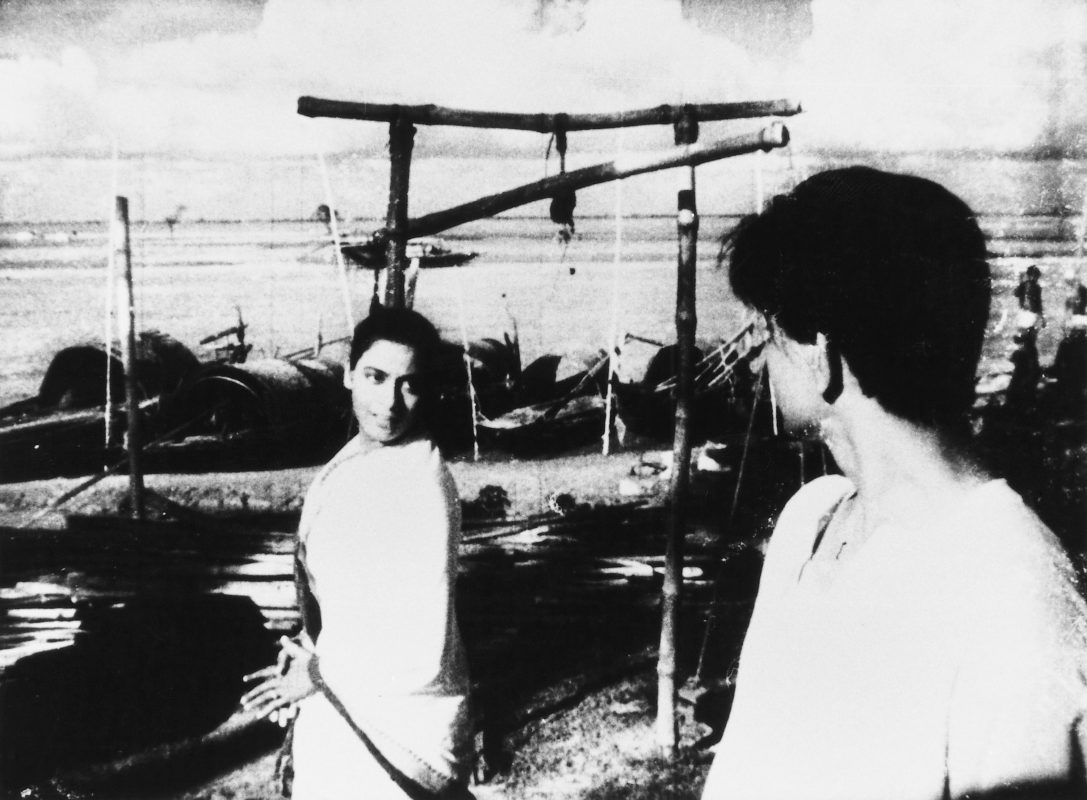
Thus, there is a link not based on a shared sense of national identity but rather the opposite: they are, through forces beyond their control, being forced to live within a particular political border where they have no emotional roots. Ghatak talks about how both the Partition and Independence have shaken the notion of the commonplace, how the nation-building project has displaced people from their emotional roots in land and property.
A character cries out to another, “Amar Padma Ma-ke mathai thekacchen?” (“Are you worshipping my mother Padma by taking a handful of her water and putting it on your head?”). Thus, the river itself also participates in this archetypal continuum of motherhood.
The image of the River Padma in E-Flat joins as well as separates East from West Bengal. Scholar Diamond Oberoi Vahali states, “The river Padma becomes symbolic of a division which, though it can apparently be overcome, is yet so rigid that it is impossible to get through it.” Pre-Partition, Anasuya and Bhrigu would have to reach Lalgola and cross the river Padma to go to their respective country home.
Post-Partition, the least they could do is stand on the banks of the Padma and lament about a familiar place that either they are unable to locate or they cannot return to any further. Thus, while standing on the banks of Padma, Anasuya and Bhrigu realize that their home lies somewhere there, so close, but they can never go there again because that has now become a foreign land and they have become outsiders, destitutes overnight.
Padma’s Elegy
Scholar Kamayani Kaushiva says Komal Gandhar “reverberates with an old folksong—‘Aey paar paddaa o paar paddaa/Moddi khaaney chaur/Tahaar moddeye bosheye/Aachen shibo saudagor’ (On this bank is the river Padma/On the other bank is the Padma too/And an island lies between them/Where lives Lord Shiva/The trader great)—which voices the agony of millions who were perplexed by the division of their land.”
Scholar Anindya Raychaudhuri writes, “From the Padma and the Titas (both now in Bangladesh) to the Subarnarekha and the Ganga (in West Bengal), Ghatak’s imagination seems to be almost instinctively attracted to the beauty of the river.” In E-flat, the unison of creativity of the characters’ experience touring rural Bengal is contrasted with the infighting and interpersonal rivalries that engulf them when they are in Calcutta. It is on the banks of the Padma River that Bhrigu and Anasuya first become close and subsequently share their memories of the loss they both suffered as a result of Partition.
The Lalgola sequence of e-Flat showcases Ritwik Ghatak’s political aspiration about the partition of Bengal. The two protagonists of the quarrelling theatre groups, Anasuya and Bhrigu, while expressing their deep love for a lost land which used to be their home, make the banks of the river Padma a site of reflection as they walk and talk about their past.
River Padma is a prominent feature and figure in “Komal Gandhar.” Throughout the conversational walk-and-talk sequence between Anasuya and Bhrigu in “Komal Gandhar,” the river Padma is seen to always seen in the background. The river is a sign of conjunction and disjunction. Padma connects East Bengal with West Bengal; on the other it also separates the two.
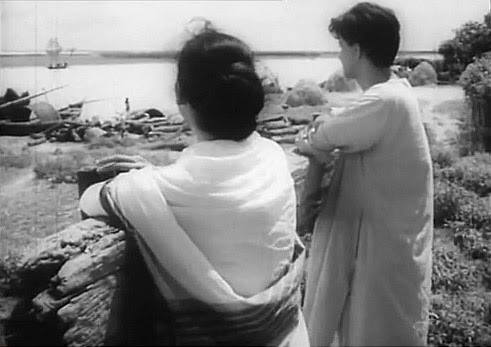
Scholar Anindya Raychaudhuri tells, rivers can serve as both symbols of the lost home and barriers preventing one’s return. There are scenes where the East Bengali actors at seeing the Padma again, are unalloyed, while in contrast, the central characters bear the tides of pain at the same site. One character goes to the silted-up island in the middle of the river and touches his forehead with the water. His worship of the Mother river is juxtaposed with Bhrigu and Anasuya standing and lamenting on the gulf of the same river between them and their lost homes.
The river Padma witnesses the emotional experience of standing at a border. Looking over onto the other side, a place where one had access to at one time, but due to the existence of a border, the place is out of bounds. River Padma separates two members of the altercating theatre groups, who also happen to be refugees, from their homeland, East Bengal. The dialogue between Bhrigu and Anusua against the background of the River Padma marks and begins a harmonizing polyphony.


![Baba Baby O [2022] Review: Neither Deep in Its Theme, Nor Succeeding in Its Execution](https://79468c92.delivery.rocketcdn.me/wp-content/uploads/2022/03/Baba-Baby-O-2-768x512.jpg)

